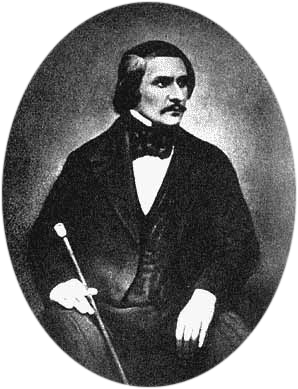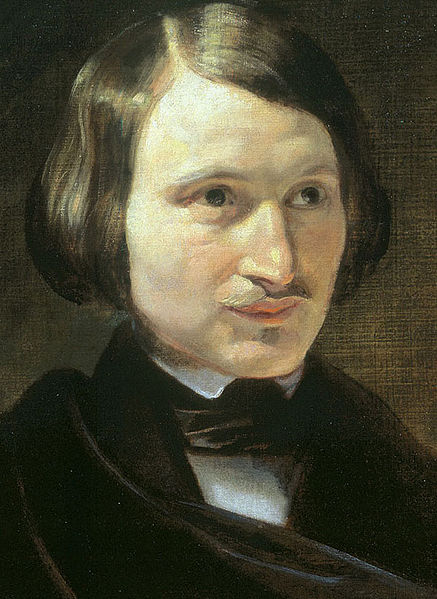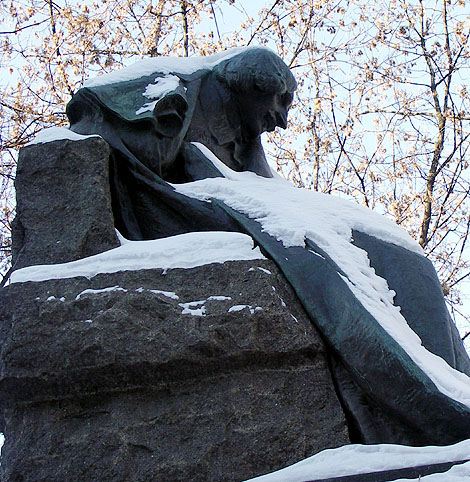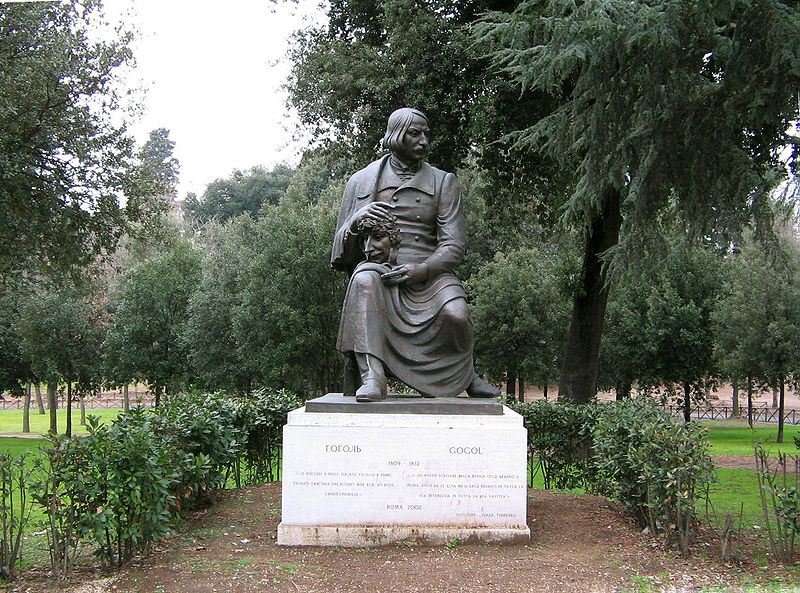<Back to Index>
- Dramatist and Novelist Nikolai Vasilievich Gogol, 1809
PAGE SPONSOR



Nikolai Vasilievich Gogol (Russian: Никола́й Васи́льевич Го́голь; Ukrainian: Мико́ла Васи́льович Го́голь; 31 March 1809 – 4 March 1852 O.S.; 19 March 1809 – 21 February 1852 N.S.) was a Ukrainian - born Russian dramatist and novelist.
Considered by his contemporaries one of the preeminent figures of the natural school of Russian literary realism, later critics have found in Gogol's work a fundamentally romantic sensibility, with strains of Surrealism and the grotesque ("The Nose", "Viy", "The Overcoat," "Nevsky Prospekt"). His early works, such as Evenings on a Farm Near Dikanka, were influenced by his Ukrainian upbringing, Ukrainian culture and folklore. His later writing satirized political corruption in the Russian Empire (The Government Inspector, Dead Souls), leading to his eventual exile. The novel Taras Bulba (1835) and the play Marriage (1842), along with the short stories "Diary of a Madman", "The Tale of How Ivan Ivanovich Quarreled with Ivan Nikiforovich", "The Portrait" and "The Carriage", round out the tally of his best known works.
Gogol was born in the Ukrainian Cossack village of Sorochyntsi, in Poltava Governorate of the Russian Empire, present day Ukraine. His mother was a descendant of Polish landowners. His father Vasily Gogol - Yanovsky, a descendant of Ukrainian Cossacks, belonged to the 'petty gentry', wrote poetry in Ukrainian and Russian, and was an amateur Ukrainian language playwright, who died when Gogol was 15 years old. As was typical of the left bank Ukrainian gentry of the early nineteenth century, the family spoke Russian as well as Ukrainian. As a child, Gogol helped stage Ukrainian language plays in his uncle's home theater.
In 1820 Gogol went to a school of higher art in Nizhyn and remained there until 1828. It was there that he began writing. He was not popular among his schoolmates, who called him their "mysterious dwarf", but with two or three of them he formed lasting friendships. Very early he developed a dark and secretive disposition, marked by a painful self - consciousness and boundless ambition. Equally early he developed a talent for mimicry, which later made him a matchless reader of his own works and induced him to toy with the idea of becoming an actor.
In 1828, on leaving school, Gogol came to St Petersburg, full of vague but glowingly ambitious hopes. He had hoped for literary fame, and brought with him a Romantic poem of German idyllic life – Hans Küchelgarten. He had it published, at his own expense, under the name of "V. Alov." The magazines he sent it to almost universally derided it. He bought all the copies and destroyed them, swearing never to write poetry again.
Gogol was one of the first masters of the short story, alongside Alexander Pushkin, Prosper Mérimée, E.T.A. Hoffmann, and Nathaniel Hawthorne. He was in touch with the "literary aristocracy", had a story published in Anton Delvig's Northern Flowers, was taken up by Vasily Zhukovsky and Pyotr Pletnyov, and (in 1831) was introduced to Pushkin.
In 1831, he brought out the first volume of his Ukrainian stories (Evenings on a Farm Near Dikanka), which met with immediate success. He followed it in 1832 with a second volume, and in 1835 by two volumes of stories entitled Mirgorod, as well as by two volumes of miscellaneous prose entitled Arabesques. At this time Russian editors and critics such as Nikolai Polevoy and Nikolai Nadezhdin saw in Gogol the emergence of a Ukrainian, rather than Russian, writer, using his works to illustrate supposed differences between Russian and Ukrainian national characters, a fact that has been overlooked in later Russian literary history. At this time, Gogol developed a passion for Ukrainian history and tried to obtain an appointment to the history department at Kiev University. Despite the support of Pushkin and Sergey Uvarov, the Russian minister of education, his appointment was blocked by a Kievan bureaucrat on the grounds that he was unqualified. His fictional story Taras Bulba, based on the history of Ukrainian cossacks, was the result of this phase in his interests. During this time he also developed a close and life long friendship with another Ukrainian, the historian and naturalist Mykhaylo Maksymovych.
In 1834 Gogol was made Professor of Medieval History at the University of St. Petersburg,
a job for which he had no qualifications. He turned in a performance
ludicrous enough to warrant satiric treatment in one of his own stories.
After an introductory lecture made up of brilliant generalizations
which the 'historian' had prudently prepared and memorized, he gave up
all pretense at erudition and teaching, missed two lectures out of
three, and when he did appear, muttered unintelligibly through his
teeth. At the final examination, he sat in utter silence with a black
handkerchief wrapped around his head, simulating a toothache, while
another professor interrogated the students." This academic venture proved a failure and he resigned his chair in 1835.
Between 1832 and 1836 Gogol worked with great energy, and though almost all his work has in one way or another its sources in these four years of contact with Pushkin, he had not yet decided that his ambitions were to be fulfilled by success in literature. During this time, the Russian critics Stepan Shevyrev and Vissarion Belinsky, contradicting earlier critics, reclassified Gogol from a Ukrainian to a Russian writer. It was only after the presentation, on 19 April 1836, of his comedy The Government Inspector (Revizor) that he finally came to believe in his literary vocation. The comedy, a violent satire of Russian provincial bureaucracy, was staged thanks only to the intervention of the emperor, Nicholas I.
From 1836 to 1848 Gogol lived abroad, traveling through Germany and Switzerland. Gogol spent the winter of 1836 – 1837 in Paris, among Russian expatriates and Polish exiles, frequently meeting the Polish poets Adam Mickiewicz and Bohdan Zaleski. He eventually settled in Rome. For much of the twelve years from 1836 Gogol was in Italy. He studied art, read Italian literature and developed a passion for opera. He mingled with Russian and other visitors, and in 1838 met Count Ioseph Vielhorskiy, the 23 year old son of the official who had brought Gogol's Government Inspector to the attention of the emperor. Vielhorsky was traveling in hopes of curing his tuberculosis. Gogol became deeply attached to the young man and attended him in his illness, but in 1839 Vielhorsky died. Gogol left an account of this time in his Nights at the Villa.
Pushkin's death produced a strong impression on Gogol. His principal work during years following Pushkin's death was the satirical epic Dead Souls. Concurrently, he worked at other tasks – recast Taras Bulba and The Portrait, completed his second comedy, Marriage (Zhenitba), wrote the fragment Rome and his most famous short story, The Overcoat.
In 1841 the first part of Dead Souls was ready, and Gogol took it to Russia to supervise its printing. It appeared in Moscow in 1842, under the title, imposed by the censorship, of The Adventures of Chichikov. The book instantly established his reputation as the greatest prose writer in the language.
After the triumph of Dead Souls,
Gogol came to be regarded by his contemporaries as a great satirist who
lampooned the unseemly sides of Imperial Russia. Little did they know
that Dead Souls was but the first part of a planned modern day counterpart to The Divine Comedy. The first part represented the Inferno;
the second part was to depict the gradual purification and
transformation of the rogue Chichikov under the influence of virtuous publicans and governors — Purgatory.
From Palestine Gogol returned to Russia, and passed his last years in restless movement throughout the country. While visiting the capitals, he stayed with friends such as Mikhail Pogodin and Sergei Aksakov. During this period he also spent much time with his old Ukrainian friends, Maksymovych and Osyp Bodiansky. More importantly, he intensified his relationship with a starets or spiritual elder, Matvey Konstantinovsky, whom he had known for several years. Konstantinovsky seems to have strengthened in Gogol the fear of perdition by insisting on the sinfulness of all his imaginative work. His health was undermined by exaggerated ascetic practices and he fell into a state of deep depression. On the night of 24 February 1852, he burned some of his manuscripts, which contained most of the second part of Dead Souls. He explained this as a mistake, a practical joke played on him by the Devil. Soon thereafter he took to bed, refused all food, and died in great pain nine days later.
Gogol was mourned in the Saint Tatiana church at the Moscow University before his burial and then buried at the Danilov Monastery, close to his fellow Slavophile Aleksey Khomyakov. In 1931 Moscow authorities decided to demolish the monastery and had his remains transferred to the Novodevichy Cemetery.
His body was discovered lying face down; which gave rise to the story that Gogol had been buried alive. A Soviet critic even cut a part of his jacket to use as a binding for his copy of Dead Souls. A piece of rock which used to stand on his grave at the Danilov was reused for the tomb of Gogol's admirer Mikhail Bulgakov.
The first Gogol monument in Moscow was a Symbolist statue on Arbat Square, which represented the sculptor Nikolay Andreyev's idea of Gogol, rather than the real man. Unveiled in 1909, the statue was praised by Ilya Repin and Leo Tolstoy as an outstanding projection of Gogol's tortured personality. Joseph Stalin did not like it, however; and the statue was replaced by a more orthodox Socialist Realism monument
in 1952. It took enormous efforts to save Andreyev's original work from
destruction; it now stands in front of the house where Gogol died.
D.S. Mirsky characterized Gogol's universe as "one of the most marvelous, unexpected — in the strictest sense, original — worlds ever created by an artist of words".
The other main characteristic of Gogol's writing is his impressionist vision of reality and people. He saw the outer world romantically metamorphosed, a singular gift particularly evident from the fantastic spatial transformations in his Gothic stories, A Terrible Vengeance and A Bewitched Place. His pictures of nature are strange mounds of detail heaped on detail, resulting in an unconnected chaos of things. His people are caricatures, drawn with the method of the caricaturist — which is to exaggerate salient features and to reduce them to geometrical pattern. But these cartoons have a convincingness, a truthfulness, and inevitability — attained as a rule by slight but definitive strokes of unexpected reality — that seems to beggar the visible world itself.
The aspect under which the mature Gogol sees reality is expressed by the untranslatable Russian word poshlost',
which is perhaps best rendered as "self - satisfied inferiority", moral
and spiritual, widespread in some group or society (from Russian, poshlo,
meaning "went"). Like Sterne before him, Gogol was a great destroyer of
prohibitions and romantic illusions. It was he who undermined Russian
Romanticism by making vulgarity reign where only the sublime and the
beautiful had reigned. "Characteristic
of Gogol is a sense of boundless superfluity that is soon revealed as
utter emptiness and a rich comedy that suddenly turns into metaphysical
horror." His stories often interweave pathos and mockery, while "The Tale of How Ivan Ivanovich Quarreled with Ivan Nikiforovich" begins as a merry farce and ends with the famous dictum, "It is dull in this world, gentlemen!"
Gogol was stunned when The Government Inspector came to be interpreted by many, despite Nicholas I's patronage of the play, as an indictment of Tsarism. In reality, Gogol himself was an adherent of the Slavophile movement and believed in a divinely inspired mission for both the House of Romanov and the Russian Orthodox Church. Similarly to Fyodor Dostoyevsky, Gogol sharply disagreed with those Russians who preached Constitutional Monarchy and the Disestablishment of the Orthodox Church.
After defending Autocracy, Serfdom, and Orthodoxy in his book Selected Passages from Correspondence with his Friends, Gogol was attacked by his former patron Vissarion Belinsky. The first Russian intellectual to publicly preach the economic theories of Karl Marx, Belinsky accused Gogol of betraying his readership by defending the status quo.
Even before the publication of Dead Souls, Belinsky recognized Gogol as the first realist writer in the language and the head of the Natural School, to which he also assigned such younger or lesser authors as Goncharov, Turgenev, Dmitry Grigorovich, Vladimir Dahl and Vladimir Sollogub. Gogol himself seemed to be skeptical about the existence of such a literary movement. Although he recognized "several young writers" who "have shown a particular desire to observe real life", he upbraided the deficient composition and style of their works. Nevertheless, subsequent generations of radical critics celebrated Gogol (the author in whose world a nose roams the streets of the Russian capital) as a great realist, a reputation decried by the Encyclopædia Britannica as "the triumph of Gogolesque irony."
The period of modernism saw a revival of interest in and a change of attitude towards Gogol's work. One of the pioneering works of Russian formalism was Eichenbaum's reappraisal of The Overcoat. In the 1920s, a group of Russian short story writers, known as the Serapion Brothers,
placed Gogol among their precursors and consciously sought to imitate
his techniques. The leading novelists of the period – notably Yevgeny Zamyatin and Mikhail Bulgakov – also admired Gogol and followed in his footsteps. In 1926, Vsevolod Meyerhold staged The Government Inspector as
a "comedy of the absurd situation", revealing to his fascinated
spectators a corrupt world of endless self - deception. In 1934, Andrei Bely published
the most meticulous study of Gogol's literary techniques up to that
date, in which he analyzed the colors prevalent in Gogol's work
depending on the period, his impressionistic use of verbs, expressive
discontinuity of his syntax, complicated rhythmical patterns of his
sentences, and many other secrets of his craft. Based on this work, Vladimir Nabokov published a summary account of Gogol's masterpieces in 1944.
Gogol's impact on Russian literature has been enduring, yet his works have been appreciated differently by various critics. Belinsky, for instance, berated his horror stories as "moribund, monstrous works", while Andrei Bely counted them among his most stylistically daring creations. Nabokov singled out Dead Souls, The Government Inspector, and The Overcoat as the works of genius and dismissed the remainder as puerile essays. The latter story has been traditionally interpreted as a masterpiece of "humanitarian realism", but Nabokov and some other attentive readers argued that "holes in the language" make the story susceptible to another interpretation, as a supernatural tale about a ghostly double of a "small man." Of all Gogol's stories, The Nose has stubbornly defied all abstruse interpretations: D.S. Mirsky declared it "a piece of sheer play, almost sheer nonsense."
Gogol's oeuvre has also had a large impact on Russia's non - literary culture, and his stories have been adapted numerous times into opera and film. Russian Composer Alfred Schnittke wrote the eight part Gogol Suite as incidental music to The Government Inspector performed as a play, and composer Dmitri Shostakovich set The Nose as
his first opera in 1930, despite the peculiar choice of subject for
what was meant to initiate the great tradition of Soviet opera. Most recently, to celebrate the 200th anniversary of Gogol's birth, Vienna's renowned Theater an der Wien commissioned music and libretto for a full length opera on the life of Gogol from Russian composer and writer Lera Auerbach.
Some attention has also been given to the apparent anti - Semitism in Gogol's writings, as well as those of his contemporary, Fyodor Dostoyevsky. Felix Dreizin and David Guaspari, for example, in their The Russian Soul and the Jew: Essays in Literary Ethnocentricis discuss "the significance of the Jewish characters and the negative image of the Ukrainian Jewish community in Gogol's novel Taras Bulba, pointing out Gogol's attachment to anti - Jewish prejudices prevalent in Russian and Ukrainian culture." In Leon Poliakov's The History of Antisemitism, the author mentions that "The 'Yankel' from Taras Bulba indeed became the archetypal Jew in Russian literature. Gogol painted him as supremely exploitative, cowardly, and repulsive, albeit capable of gratitude. But it seems perfectly natural in the story that he and his cohorts be drowned in the Dniper by the Cossack lords. Above all, Yankel is ridiculous, and the image of the plucked chicken that Gogol used has made the rounds of great Russian authors."
Despite
his problematic portrayal of Jewish characters, Gogol left a powerful
impression even on Jewish writers who inherited his literary legacy.
Amelia Glaser has noted the influence of Gogol's literary innovations on Sholem Aleichem,
who "chose to model much of his writing, and even his appearance, on
Gogol... What Sholem Aleichem was borrowing from Gogol was a rural East
European landscape that may have been dangerous, but could unite readers
through the power of collective memory. He also learned from Gogol to
soften this danger through laughter, and he often rewrites Gogol's
Jewish characters, correcting anti - Semitic stereotypes and narrating
history from a Jewish perspective."

